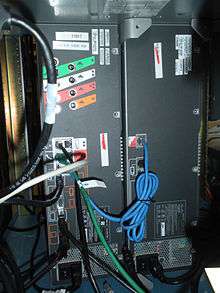Cisco TelePresence
Cisco TelePresence, first introduced in October 2006, is a range of products developed by Cisco Systems designed to link two physically separated rooms so they resemble a single conference room regardless of location.
Cisco documented the Telepresence concept and implementation details in the book Cisco TelePresence Fundamentals,[1] where the difference between Telepresence and the at this point in time prevalent Videoconferencing is defined as quality, simplicity, and reliability.

Products
These were the initial products:
- CTS-3000 - Room system for 6 persons
- CTS-1000 - Room system for 2 persons
- CTMS - Multipoint collaboration network appliance that connected multiple room systems into a single conference
- CTS-Man - Management application for integration with groupware, such as Microsoft Exchange which gives the system the ability to schedule meetings[2]
They were designed for an experience to feel as if local and remote participants are in the same room.[3] These products offer features including up to three 1080p flat panel displays, special tables, microphones, speakers, cameras, collaboration interfaces and lighting.[4]
In 2008 Cisco reported to have sold about 2,000 rooms, with about another 250 non-revenue (internal and philanthropic) units installed.[5]
Later other products were developed that expanded the use-cases for smaller offices and Webex connectivity.
In 2010 the Norwegian company Tandberg was acquired and the products got integrated into the Cisco portfolio.
Currently there is a wide range of collaboration endpoints [6] and conferencing infrastructure products [7] offered.
Marketing
- The television series 24 featured Cisco Telepresence product placements.
- Season 8. Episode 8 of NCIS also featured Cisco Telepresence product placements.
References
- ↑ Szigeti, McMenamy, Saville, Glowacki, Cisco TelePresence Fundamentals, Cisco Press, 2009, ISBN 978-1587055935
- ↑ TelePresence Manager Information - Cisco Systems
- ↑ Cisco TelePresence System 3000 Series
- ↑ Cisco's TelePresence Meeting does video meetings in ultra-HD - Engadget
- ↑ "Customer Adoption Drives Cisco TelePresence to 500-Unit Milestone" (Press release). Cisco Systems. 2008-04-20.
- ↑ Cisco Collaboration Endpoint Overview
- ↑ Cisco Conferencing Overview